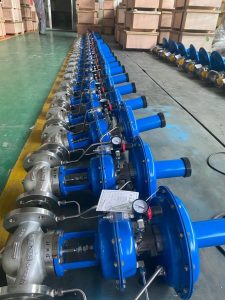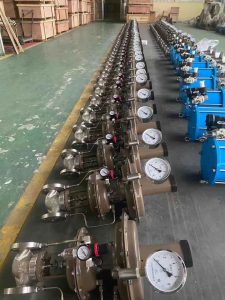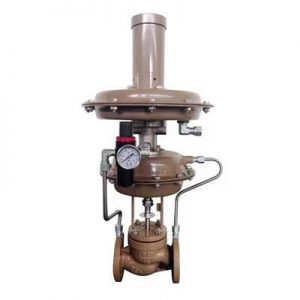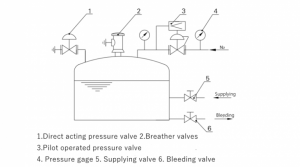A Pressure Reducing Valve (PRV) is an Automatic Control Valve designed to reduce a higher unregulated inlet pressure to a constant, reduced downstream (outlet) pressure regardless of variations in demand and/or upstream (inlet) water pressure.
What is a Tank Blanketing Valve?
First, we need to know what tank blanketing is, tank blanketing is the process of filling the empty space of a liquid storage tank with inert gas, such as nitrogen gas. Why nitrogen gas? because nitrogen gas is a kind of inert properties and is a more available and relatively low-cost medium, it is an excellent choice for tank blanketing.
Nitrogen blanketing system is complete of devices to maintain a constant pressure state by injecting N2 gas, that is, inert gas to the upper room of the tank storage. It is composed of a series of Nitrogen high pressure reducing valve (supplying valves/bleeding valves), breather valves, pressure gage and other piping system and safety device, it can work smoothly without external energy like electricity or gas, featured the advantages of simple, convenient and economical, easy to maintain. Nitrogen blanketing system prevents any vacuum from development and reduces the evaporation, which maintains the storage tank to a designed pressure value, has been wildly used in the storage tanks, reactors & centrifuges of refineries & chemicals plants.
When the bleeding valve of the storage tank is opened, the liquid level drops, the gas phase volume increases and the nitrogen pressure decreases. Then the nitrogen supply valve opens and injects nitrogen into the tank. When the nitrogen pressure in the tank rises to the set value of the nitrogen supplying valve, it will automatically close. Instead, when the tank supplying valve is opened to supply nitrogen to the tank, the liquid level rises, the gas phase volume decreases and the pressure increases. If the pressure is higher than the set value of the nitrogen relief valve, the nitrogen relief valve will open and release nitrogen and make the nitrogen pressure in the tank drop. When the nitrogen relief valve drops to the set value of the nitrogen relief valve, it will automatically close.
Generally speaking, the nitrogen supplying regulator can be a type of Pilot Operated and self-operated pressure control valve, the nitrogen discharge device adopts the self-operated micro-pressure control valve, of which diameter is generally the same as the inlet valve diameter; The breather valve is installed on the top of the tank and is designed for explosion and fire protection. Nitrogen supplying pressure is around 300~800KPa, nitrogen blanketing set pressure is 1KPa, nitrogen bleeding pressure is 1.5kpa, respiration valve exhalation pressure is 2KPa and in-breathing pressure -0.8 KPa; The breather valve does not work normally only when the main valve fails and the pressure in the tank is too high or too low.
We offer a complete tank blanketing system with safety devices along with Nitrogen high pressure reducing valves and components for storage tanks, reactors & centrifuges.
Application
- Tank Blanketing
- Natural Gas
- Oil&Gas
- Pressure Reducing
- Food & Beverage
- Pharma
- Chemical
- Petrochemical










